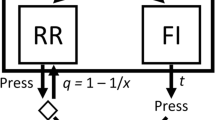Abstract
Two experiments using rats show the effects of introducing response-reinforcer contiguity on a modified recycling conjunctive fixed-time 30 s fixed-ratio 1 schedule of food reinforcement. In Experiment 1, the frequency of programmed contiguity was varied across conditions. The general finding was an increase in overall rate of responding for all rats when the incidence of obtained cont iguity was relatively high. This increase in responding was accompanied by unusual response patterns for some rats. These patterns persisted when the rats were subsequently exposed to a fixed-interval schedule. Other rats produced fixed-interval-like performance when the incidence of obtained contiguity increased. Similar findings were observed in Experiment 2 where a more direct comparison was made between the modified recycling conjunctive schedule and the fixed-interval schedule. Results in general emphasize the importance of the modified recycling conjunctive schedule as a tool for exploring behavioral adaptation to periodic reinforcement. The history effects reported in both experiments are discussed with reference to the notion of schedule-induced behavior and temporal control.
Similar content being viewed by others
References
ANDERSON, M. C. & SHETTLEWORTH, S. J. (1977). Behavioral adaptation to fixed-interval and fixed-time food delivery in golden hamsters. Journal of the Experimental Analysis of Behavior, 27, 33–49.
BARON, A., & LEINENWEBER, A. (1994). Molecular and molar analyses of fixed-interval performance. Journal of the Experimental Analysis of Behavior, 61, 11–18.
BARON, A., & LEINENWEBER, A. (1995). Effects of a variable-ratio conditioning history on sensitivity to fixed-interval contingencies in rats. Journal of the Experimental Analysis of Behavior, 63, 97–110.
BICKEL, W. K., HIGGINS, S. T., KIRBY, K., & JOHNSTON, L. M. (1988). An inverse relationship between baseline fixed-interval response rate and the effects of a tandem response requirement. Journal of the Experimental Analysis of Behavior, 50, 211–218.
BLACKMAN, D. E. (1983). On cognitive theories ot animal learning: Extrapolation from humans to animals? In G. C. L. Davey (Ed.), Animal models of human behavior. New York: John Wiley & Sons Ltd.
CATANIA, A. C. (1998). Learning (4th ed.). Upper Saddle River, NJ: Prentice-Hall, Inc.
CHURCH, R. M. (1978). The internal clock. In S. H. Hulse, H. Fowler, & W. K. Honig (Eds), Cognitive processes in animal behavior. Hillsdale, NJ: Erlbaum Associates.
CUMMING, W. W., & SCHOENFELD, W. N. (1958). Behavior under extended exposure to a high-value fixed-interval schedule. Journal of the Experimental Analysis of Behavior, 1, 245–263.
DAVEY, G. (1987). Animal learning and conditioning. London: Macmillan Education.
DEWS, P. B. (1970). The theory of fixed-interval responding. In W. N. Schoenfeld (Ed.), The theory of reinforcement schedules (pp. 43–61). New York: Appleton-Century-Crofts.
FERSTER, C. B., & SKINNER, B. F. (1957). Schedules of reinforcement. New York: Appleton-Century-Crofts.
HYTEN, C., & MADDEN, G. J. (1993). The scallop in human fixed-interval research: A review of problems with data description. The Psychological Record, 43, 471–500.
JOHNSTON, L. M., BICKEL, W. K., HIGGINS, S. T., & MORRIS, E. K. (1991). The effects of schedule history and opportunity for adjunctive responding on behavior during a fixed-interval schedule of reinforcement. Journal of the Experimental Analysis of Behavior, 55, 313–322.
KEENAN, M. (1982). Behavioural organisation in schedules of reinforcement. Unpublished D. Phil, thesis. University of Ulster.
KEENAN, M. (1986). Second-order schedules. The Psychological Record, 36, 407–417.
KEENAN, M., & LESLIE, J. C. (1986). Varying response-reinforcer contiguity in a recycling conjunctive schedule. Journal of the Experimental Analysis of Behavior, 45, 317–332.
KEENAN, M., & TOAL, L. (1991). Periodic reinforcement and second-order schedules. The Psychological Record, 41, 87–115.
KEENAN, M., & WATT, A. (1990). Concurrent behavior and response reinforcer contiguity. The Psychological Record, 40, 127–138.
LEINENWEBER, A., NIETZEL, S. M., & BARON, A. (1996). Temporal control by progressive-interval schedules of reinforcement. Journal of the Experimental Analysis of Behavior, 66, 311–326.
LESLIE, J. C. (1996). Principles of behavior analysis. Amsterdam: Harwood Academic Publishers GmbH.
LOWE, C. F, & WEARDEN, J. H. (1981). Weber’s law and the fixed-interval post reinforcement pause. Behavior Analysis Letters, 1, 27–37.
MORSE, W. H., & KELLEHER, R. T. (1977). Determinants of reinforcement and punishment. In W. K. Honig & J. E. R. Staddon (Eds.), Handbook of operant behavior (pp. 174–200). Englewood Cliffs, NJ: Prentice-Hall.
RICHELLE, M., & LEJEUNE, H. (1980). Time in animal behaviour. Oxford: Pergamon.
STADDON, J. E. R. (1983). Adaptive behavior and learning. New York: Cambridge University Press.
STADDON, J. E. R. (1977). Schedule-induced behavior. In W. K. Honig & J. E. R. Staddon (Eds.), Handbook of operant behavior (pp. 125–153). Englewood Cliffs, NJ: Prentice-Hall.
TATHAM, T. A., WANCHISEN, B. A., & HINELINE, P. A. (1993). Effects of fixed and variable ratios on human behavioral variability. Journal of the Experimental Analysis of Behavior, 59, 349–359.
THOMAS, G. (1981). Contiguity, reinforcement rate and the law of effect. Quarterly Journal of Experimental Psychology, 33B, 33–43.
WANCHISEN, B. A., TATHAM, T. A., & MOONEY, S. E. (1989). Variable-ratio conditioning history produces high- and low-rate fixed-interval performance in rats. Journal of the Experimental Analysis of Behavior, 52, 167–179.
ZEILER, M. D. (1977). Schedules of reinforcement: The controlling variables. In W. K. Honig & J. E. R. Staddon (Eds.), Handbook of operant behavior (pp. 201–232). Englewood Cliffs, NJ: Prentice-Hall.
Author information
Authors and Affiliations
Corresponding author
Rights and permissions
About this article
Cite this article
Keenan, M. Periodic Response-Reinforcer Contiguity: Temporal Control but not as We Know It!. Psychol Rec 49, 273–297 (1999). https://doi.org/10.1007/BF03395321
Published:
Issue Date:
DOI: https://doi.org/10.1007/BF03395321




